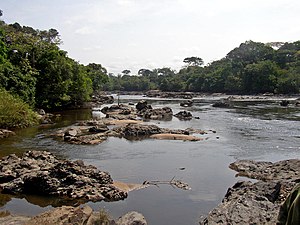Yita Wikipedia, encyclopedia zaalem'a
| Inception | 1992 |
|---|---|
| Native label | Réserve de faune à okapis |
| IUCN protected areas category | IUCN category II: National Park |
| Country | Democratic Republic of the Congo |
| Located in the administrative territorial entity | Ituri Province |
| Coordinate location | 2°0′0″N 28°30′0″E |
| Authority | Institut Congolais pour la Conservation de la Nature |
| Significant event | list of World Heritage in Danger |
| Significant place | Isiro |
| Heritage designation | World Heritage Site |
| Official website | https://www.okapiconservation.org/ |
| World Heritage criteria | (x) |


Okapi Weo-vɩɩm Zĩ-bĩngrã ya weoog bũn-yood zĩiga sẽn be Ituri Weoogẽ wã, weoog kãnga bee Kõngo Nin-buiid-naam Tẽnga rɩtg baobg n debd yaanga, n kolgd Wĩn-goabg Sudã ne Ugãnda toose.[1] A yalma zemsa km2 14 000, weoogã zĩis a nu tɩ b yãk yembr mamsgo. Yʋʋm 1996, Okapi Weo-vɩɩm Zĩ-bĩngrã kẽe Inɛsko Dũni Faad Zĩigẽ, n tũud ne a okapi rãmb ka tɛkse sẽn be meneng pʋgẽ la ne a tẽn-gãonga laogo.
Belem tuse
- Zĩig ne a rãmb baoosgo
- Kʋdemde
- Koglgo
- Sãnem zĩiga
- Nin-wẽnsa tʋʋma
- Ges-n-paase
- Sebtiise
- kaoreng sẽn be taoore
- Kɛɛng tõkre
Zĩig ne a rãmb baoosgo
Kʋdemde
Chris Wickham, Roman ãndũni pʋgdenga taoor zãomsgo, "Framing the Early Middle Ages" (2006) mãanda no-koeemd ti yir bãmba ra yaa arzɛk-koaada yiya sẽn pa wẽnegd galen-tẽnse ye. Yiya sẽn pa wã yii koaada arzɛk nins b sẽn paame b zamaan-zẽns Olive kaam leebgo pʋge.[2][3]
A le yeela mɩ tɩ tẽn-bɛda bãmb yaa tẽnse nins sẽnda nõbe b sẽn be Byzantine Empire wã leebgo so-kõaada yaalg zuga. Leebga soda teka mɩ sasa nina Arabs rãmba sẽn tõog ba tɩ kɩ t tẽnsa kong b tʋʋmd nins sẽnda pidsri b arzɛk koglgo rãmba. Dɩwã yaa, tẽng-n-biisa basa b tẽnse la b zoe n tɩ zĩnd ne Arab rãmba.[4]
Okapi wildlife wã tẽn-bãooneg Kʋta wɩligda ãndũni sẽn tek n yi DR Congo yel-manesem n wa kẽ Byzantine tiugungu pʋge.[5][6]
Okapi wildlife wã lebga UNESCO World Heritage Site yʋʋmde 2011. B kẽesgo yʋʋr la "Ancient Villages of North Syria".
Nẽb sɩnge n reng n kẽed zĩisa pʋge tɩ world heritage. Tẽn-kɩɩng rãmba wʋsgo da ping n zãagame tɩ yamleo-gõaadba da tõog n kẽera zĩisa yol-yol ba ne Okapi wildlife wã kẽer taab yaa toogo (Abdallah Hadjar lɛgend tũuda seb-karemdga beemɩ ne zĩig mams-rẽesdem sẽn nan kɩ tɩ neb tõog n padme zĩis nins sẽn paamd yaa toogo: St Simeon Stylites Wẽn-roogo la Archaeology Zĩis sẽn be Simeon ne Halaqa Tãn-bɛda (Mountains) zugu.
Nin-wẽnsa tʋʋma
Yuumde 2012 pugin, Nin-wẽnsa rãmba kenga Epulu Conservation ne Research zĩiga n ti maan zabre n leeb n yooge ziiga faa ne bugum, ya Mai-Mai Nin-wẽnsa rãmba n da maan woto, Paul Sadala (alias Morgan) n ya ub taore soba.
Ges-n-paase
Sebtiise
- INSTITUT CONGOLAIS POUR LA CONSERVATION DE LA NATURE. Okapi Archived 2005-01-18 at the Wayback Machine
- Okapi Archived 1997-07-10 at the Wayback Machine
- "21 World Heritage Sites you have probably never heard of". The Telegraph. Daily Telegraph. 4 February 2016.
- "Okapi Wildlife Refuge". UNESCO World Heritage Centre. United Nations Educational, Scientific, and Cultural Organization. Retrieved 13 June 2021.
- Somers, Michael; Beyers, Rene L.; Hart, John A.; Sinclair, Anthony R. E.; Grossmann, Falk; Klinkenberg, Brian; Dino, Simeon (2011). "Resource Wars and Conflict Ivory: The Impact of Civil Conflict on Elephants in the Democratic Republic of Congo - The Case of the Okapi Reserve". PLOS ONE. 6 (11): e27129. Bibcode:2011PLoSO...627129B. doi:10.1371/journal.pone.0027129. ISSN 1932-6203. PMC 3212536. PMID 22096529.
- "Okapi Wildlife Reserve". Guide for Africa. Retrieved 2011-10-25.
- "Okapi Conservation Project". Wildlife Conservation Network.
- Mongobay (9 September 2013).A year after devastating attack, security returns to the Okapi Wildlife Reserve (photos). Retrieved 16 July 2017.
- Stokes, Elaisha (2015-02-23). "Saving Okapi in the Democratic Republic of Congo". Al Jazeera America. Retrieved 2022-10-29.
- Group of Experts on the Democratic Republic of the Congo (2021-06-10). "S/2021/560". United Nations Security Council. Retrieved 2022-10-27.
- Holland, Hereward (2021-06-22). "Congo seizes gold worth $1.9 million in Okapi wildlife reserve". Reuters. Retrieved 2022-10-28.
- Kambale, Erikas Mwisi (2022-10-19). "Congolese NGOs decry mining in main refuge of 'Africa's unicorn'". Reuters. Retrieved 2022-10-28.
- Okapi Conservation Project (28 June 2012).Okapi Conservation Project, Epulu Update – June 28, 2012 Archived September 4, 2012, at the Wayback Machine. Retrieved 15 September 2012
- Okapi Conservation Project (4 August 2012).Okapi Conservation Project, Update – August 4, 2012 Archived December 22, 2013, at the Wayback Machine. Retrieved 15 September 2012
- New York Times (16 July 2017).U.S. journalist found alive in Congo, 5 others are killed. Retrieved 16 July 2017.
- France24 (16 July 2017).Kidnapped US journalist in DR Congo found safe, five wardens killed Archived 2017-07-16 at the Wayback Machine. Retrieved 16 July 2017.
kaoreng sẽn be taoora
- Susan Lyndaker Lindsey; Mary Neel Green; Cynthia L. Bennett (1999). The Okapi. University of Texas Press. ISBN 0-292-74707-1
Kɛɛng tõkre
Sit-ramba
- ↑ https://en.wikipedia.org/wiki/Okapi_Wildlife_Reserve#cite_note-3
- ↑ INSTITUT CONGOLAIS POUR LA CONSERVATION DE LA NATURE. Okapi Archived 2005-01-18 at the Wayback Machine
- ↑ Okapi Archived 1997-07-10 at the Wayback Machine
- ↑ "21 World Heritage Sites you have probably never heard of". The Telegraph. Daily Telegraph. 4 February 2016.
- ↑ "Okapi Wildlife Refuge". UNESCO World Heritage Centre. United Nations Educational, Scientific, and Cultural Organization. Retrieved 13 June 2021.
- ↑ Somers, Michael; Beyers, Rene L.; Hart, John A.; Sinclair, Anthony R. E.; Grossmann, Falk; Klinkenberg, Brian; Dino, Simeon (2011). "Resource Wars and Conflict Ivory: The Impact of Civil Conflict on Elephants in the Democratic Republic of Congo - The Case of the Okapi Reserve". PLOS ONE. 6 (11): e27129. Bibcode:2011PLoSO...627129B. doi:10.1371/journal.pone.0027129. ISSN 1932-6203. PMC 3212536. PMID 22096529.
